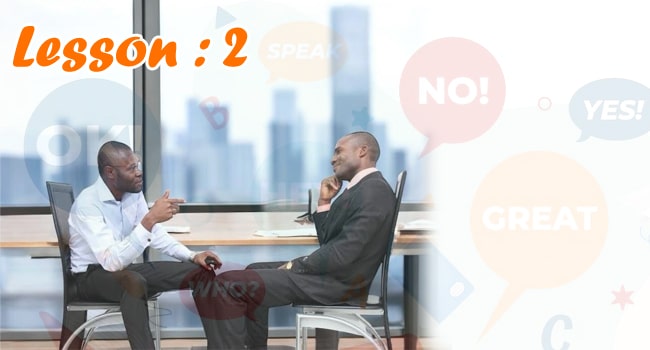
Lesson 2: Fundamentals of Conversation – Rules, Greetings, and Effective Communication
- Admin
- 0
- Posted on

Learning Objectives
By the end of this lesson, students will be able to:
- Understand the basic rules and structure of a conversation.
- Use appropriate greetings and responses in both formal and informal settings.
- Start and end conversations politely.
- Identify and use common exclamations and expressions in daily conversation.
- Engage confidently in small talk and introductions.
Introduction
The conversation is necessary to convey your views or information to others. However, conversation has few basic rules and regulation those are necessary for informal and formal conversation. There are few fundamental tips and tricks for positive and beneficial conversation. It is necessary for the conversation participants that they must be aware about the basics of conversation. Conversation is usually started with few greetings phrases or words and similarly ends with some specific phrases. It is necessary for the students and other English learner that they must be aware about these techniques and phrases. The followings are some vital conversation tips and phrases used in positive conversation.
Essential Description Of Conversation:
Conversation has different parts start from greetings and end on good-bye. The conversation is basically way of communication or sharing your view with friends or other people. Conversation is source of information, details, description and updates. In conversation generally we discuss current situation and previous events. However, after informal or formal greetings then conversation starts. If you meet someone first time in your life, then say
3. Parts of a Conversation
A conversation generally has three main parts:
- Opening (Greetings) – e.g., Hello! Hi! Good morning! How are you?
- Body (Main Talk) – exchanging information, asking questions, or discussing topics.
- Closing (Farewell) – e.g., Nice to meet you! Goodbye! See you later!
4. Basic Greetings and Responses
When you meet someone for the first time:
- “Hello! My name is Harry. Glad to meet you.”
Response: “It’s a pleasure meeting you.” or “Same here. My name is Jack.”
Common questions to start a conversation:
- “How are you?” / “What’s up?” / “What’s going on?”
Possible replies: “I’m fine.” “I’m doing great.” “Not much.” “I’m okay.”
You can continue the conversation by asking:
- “Where do you come from?”
- “Where do you live?”
- “What do you do?”
Example Replies:
- “I’m from the United Kingdom.”
- “I live in London.”
Closing Phrases:
- “Nice to meet you.” → “It’s a pleasure meeting you too.”
- “Goodbye!” → “See you later!”
5. Example: Routine Conversation Between Two Individuals
Jack: Hello!
Harry: Hi!
Jack: I’m Jack. What is your name, please?
Harry: My name is Harry.
Jack: I’m from the United States. Where are you from?
Harry: I’m from England.
Jack: I live in California, USA. Where do you live in England?
Harry: I live in the suburbs of London.
Jack: Nice to meet you, Harry.
Harry: Same here, Jack.
Jack: Goodbye! See you later.
Harry: Goodbye!
6. Types of Conversation
| Type | Description | Example |
|---|---|---|
| Formal | Used in offices, schools, or interviews. | “Good afternoon, sir. How are you today?” |
| Informal | Used with friends or family. | “Hey! What’s up?” |
| Polite | Used to show respect or courtesy. | “It’s an honor to meet you.” |
7. Common Conversation Starters
| Situation | Example Phrase |
|---|---|
| Meeting someone new | “Hi, I’m Alex. Nice to meet you.” |
| Asking about wellbeing | “How have you been?” |
| Starting small talk | “Lovely weather today, isn’t it?” |
| Asking about work/study | “What do you do?” |
| Meeting after long time | “It’s been a while! How are things?” |
8. Familiar Exclamations Used in Conversation
An exclamation (or interjection) expresses strong emotion, surprise, or excitement. It often ends with an exclamation mark (!).
Example: Wow! That’s amazing!
Common Exclamations:
| Ah | Alas | Awesome | Bing | Big deal | Bravo | Bye | Cheers |
|---|---|---|---|---|---|---|---|
| Come on | My goodness | Duck | Enjoy | Excellent | Fabulous | Fantastic | Finally |
| Great | Freeze | Golly | Goodbye | Hello | Hey | Hi | Hooray |
| Indeed | Marvelous | Dear me | No way | Ouch | Please | Welcome | Wow |
9. Common Mistakes in Conversation
- Forgetting to greet before starting the talk.
- Interrupting the speaker.
- Using slang in formal settings.
- Giving one-word answers only.
- Ending a conversation suddenly without a closing remark.
10. Useful Vocabulary & Phrases
- How’s it going?
- What brings you here?
- That sounds interesting!
- I totally agree with you.
- Really? Tell me more.
- I see your point.
- Nice talking to you!
11. Practice Activities
Activity 1: Role Play
Form pairs. One student acts as a new classmate, and the other initiates a conversation. Use at least five expressions from this lesson.
Activity 2: Group Discussion
Discuss with your group: Why is greeting important in a conversation?
Activity 3: Dialogue Writing
Write a short conversation between two strangers meeting for the first time at a bus stop.
12. Short Quiz
- Define conversation in your own words.
- Write two examples of formal greetings.
- What is the purpose of a closing remark in conversation?
- List any four exclamations.
13. Summary
Conversation is an essential skill for personal and professional life. It starts with greetings, continues with sharing thoughts and questions, and ends with a polite farewell. Using proper expressions, tone, and exclamations makes communication effective and pleasant.